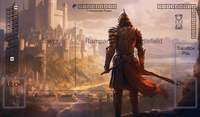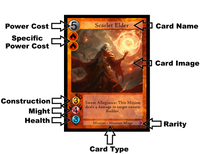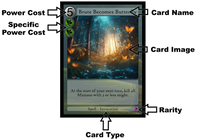How to play Towers of Babylon
Towers of Babylon is two player game. Each player starts with a play mat and a 60 card deck. See the play mat below.
Game Objective - How to win
There are two ways to win in Towers of Babylon. The first is to be the first player to have their tower reach 50 levels. The second way is to be the player with the highest tower, when both players have finished playing their 15th turn. If both players towers are at the same level, when both players have finished playing their 15th turn, the game ends in a draw.
Game Setup
To set up a game of Towers of Babylon:
- Place your decks in the square "DECK".
- Put the Tower Marker on the level counter, at number 10.
- Put the Transformer Power Marker at the Transformer Power Counter, at number 0
- Put the Turn Marker on the turn counter, on number 0.
- Choose who plays first.
- The player who plays first draws 4 cards.
- The player who plays second, draws 5 cards and move their Transformer Power Marker to 1 on the Transformer Power Counter.
- Each player may put up to 3 cards from their hand on the bottom of their deck, then draw as many cards as they put away.
Your are now ready to start playing the game!
How to start a Turn
- Move the Turn Marker one step.
- Move all your Power Sources from "Exhausted Power Sources" to "Available Power Sources".
- Ready all your Minions, by turning them so that the top of the card points up.
- Resolve any Invocations that have been played and whose text says they will resolve at the start of your turn.
- Draw a card.
- Make a decision. Either draw a second card, or make an offering. To make an offering, place a card from your hand, face up in the zone "Sacrifice Pile", then put a Power Source that matches the color of the sacrificed card, into the zone "Available Power Sources.
After this, you move on to your Main Phase.
Main Phase
During your main phase, you can make the following five actions. You can make each action as many times as you want, as long as you have the resources required.
- Play a Minion card from your hand. To play it, first pay the Power Cost of the card, by moving a number of Power Sources from "Available Power Sources" to Exhausted Power Sources", equal to the Power Cost (the number in the top left of the card). Each card has a specific cost, below the Power Cost. The specific cost says how many Power Sources used to pay for the card must have a matching symbol as the card. In The example shown, the card "Sun Blessed Paladin" has a specific cost of "2 light", meaning at least two Power Sources used to pay for it must the Light symbol. Then put the Minions on the "Ramparts" sideways (immobile).
- Play a Spell card from your hand. To play it, first pay the Power Cost of the card (same way as Minion cards are payed for, see above). Then resolve its effect, then put it into the Discard Pile.
- Move a Minion to another zone. Only Minions that are Ready (upright) can be moved like this. When a Minion is moved, turn it sideways (immobile). This shows it can't be moved again this turn.
- Use a Minion to build your tower. Minions that are in the "Tower" zone are called Builders. Only Builders can build. Exhausted Builders can't build. To build, exhaust a Builder, then move your Tower Marker, increasing the number of levels of your tower equal to the construction of the Builder.
- Use a Minion to attack the opponents minions or tower. Minions that are in the "Battlefield" zone are called Raiders. Only Raiders can attack. Exhausted Raiders can't attack. To attack, exhaust a Raider, then declare the target of the attack (either the enemy Tower or an enemy Minion). Below, under "Combat" you can read more about what happens when a Minion attacks.
End of turn
At the end of your Turn, move all your Power Source from "Available Power Sources" to "Exhausted Power Sources". Then move your Transformed Power Marker one step, for each Power Source moved this way. Transformed Power is saved from turn to turn, and can be used to pay for Witchery Spell cards.
Minions
Minions are the primary way to build your tower, defend it and disrupt your opponent. There are hundreds of different Minions, with different strengths and weaknesses. Minions have different roles, depending on in which zone they are. Minions on the Ramparts are Defenders. Minions in the Tower are Builders. Minions on the Battlefield are Raiders. Each turn your Minions can be moved to other zones, changing their roles.
Minions can also be in three different states: Ready Minions are upright, and can be moved to another zone, as well as build, defend or attack, depening on which zone they are in. Once moved, a minion becomes immobile, and can't be moved again. Immobile Minions are sideways, and can build, defend or attack depending on which zone they are in, but they can't move. Once a Minion has attacked, built or defended, it becomes exhausted. Exhausted Minions are upside down and can't move, attack, block or defend.
The image to the right shows a Minion card from the Fire Faction. The card's name is Scarlet Elder, it costs 5 Power to play from hand, and at least 2 of those have to be fire (specific Power Cost). It has 3 construction (how many levels it can construct when it builds), 4 might (how much damage it deals in a Clash), and 3 health, (how much damage it can take before it dies). Its card type is Human Mage. It is a rare card, which can be seen from it's purple rarity symbol (common cards are green, uncommon blue, rare purple and super rare are orange).
Keywords
The card text can of cards may contain different keywords. Here's a list of these keywords.
- Swear Allegiance: This is an effect that Minions can have, that triggers when the Minion enters the game.
- Offering: To make an offering, a player puts a card from his hand into the Sacrifice Pile, then gains a Power Source that shares a color with the sacrificed card. The Power Source is put into "Available Power Sources" and can be used right away.
- Shape: This is an effect that Minions can have that triggers when the Minion builds.
- Dying words: This is an effect that Minions can have, that triggers when the Minion dies.
- Tunnel: This is an ability that some Minions have. These Minions can not be blocked, when they attack the enemy Tower.
- Lethal: This is an ability that some Minions have. When these Minions deal damage to another Minion, that Minion dies.
- Thief: This is an ability that some Minions have. When these Minions deals damage to the enemy Tower, the player who controls the Minion will have their Tower gain levels equal to the damage they dealt the enemy Tower.
- Regenerating. This is an ability that some Minions have. At the start of your turn, remove all damage from these Minions.
- Crush. This is an ability that some Minions have. When these Minions become blocked by a Minion, that they kill, if they dealt more damage than the blocker had health, they deal the excess damage to the original target of their attack.
- Twinstrike: This is an ability that some Minions have. When these Minions attack, if there is one or more other enemy Minion in the same zone as the one they clash with, they also deal damage to another Minion in that zone, of the controller of the attacking Minions choice. The second Minion it damages does not Clash with the attacker, and so does not get to deal damage back to it.
- Retreating: After a Minion with Retreating has attacked, it is moved to the Ramparts.
- Sentence: To sentence a Minion. Put a Sentence marker on it. A Sentenced Minion takes 1 damage every time it becomes exhausted.
Spells
There are three different types of Spells. Commands, Witcheries and Invocations.
To play Commands and Invocations, from your hand, you pay the Power Cost with Available Power Sources, moving them to "Exhausted Power Sources", the same way you pay for Minions.
To play Witcheries, you must pay their Power Cost with Transformed Power, lowering your Transformed Power as much as the Power Cost of the Witchery card. This is tracked with your Transformed Power Marker.
Commands have an immediate effect when played, and are then discarded. Invocations have a delayed effect, such as at the beginning of the next turn. They stay in play, until their effect has resolved at the given time, and are then discarded. Witcheries are the only cards that can be played at the opponents turn. Some Witcheries can be played at any time, others can only be played in certain situations, specified on the card. These situations can be "when a friendly Minion enters the game" or "when an enemy Minion is attacking". Like Commands, Witcheries have an immediate effect, and are then discarded.
Clashing
When a Minion attacks, their controller turn the card upside down, exhausting it, and announce the target of the attack. The target can be any enemy Minion (the Minions controlled by the opponent), or the enemy Tower. If the defending player has one or more Defenders (Minions on the Ramparts), they may choose one of their Defenders, and announce that it will block the attack. However, if the attack is targeting an enemy Raider, the Defenders will be unable to block.
The attacker then Clashes with its original target, unless it was blocked. If it was blocked, it Clashes with its blocker. When Clashing, both Minions deal damage equal to its Might to the other Minion. Damage is tracked with Damage Markers. If either Minion then has a number of damage markers equal to or more than its health, it dies, and is moved to the Discard Pile. After Clashing, the defending Minion becomes Exhausted. If the attacker targeted the enemy Tower and was not blocked, it deals damage to the Tower equal to its Might, and the controller of the Tower lowers the level tracker equal to the damage dealt.







